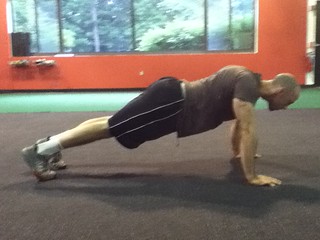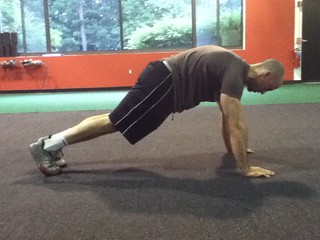Admittedly today’s Exercise You Should Be Doing won’t win a “sexiness” award like, say, pretty much any deadlift variation would, or maybe a pistol squat[footnote]If we somehow found a way to include juggling chainsaws into the mix.[/footnote], or pillow-fighting. Truth be told it’s a relatively unexciting, mundane looking exercise, but whoa Nelly! does it humble even the meatiest of meatheads.
But first pillow fighting.

Don’t knock it: pillow fighting is an excellent way to address core stability, primitive patterns, appropriate scapular upward rotation, basic combat skills, (and every teenage boy’s fantasy).
Okay, in all seriousness…lets get to today’s exercise
Prone (Val Slide) Hip Flexion-Extension
Who Did I Steal It From: this exercise has its roots in many arenas, but the person I need to give the most credit to is strength coach Dan Hechler. I saw him use this exercise with a client of his a few weeks ago and really liked it.
UPDATE: Dan actually refers to this exercise as a glorified Mt. Climber. I need to figure out a catchy name for this one other than the one I gave it. I’m so lame.
Sliding Mt. Climber?
Mt. Climber McSuckington?
I don’t know, I’m lame.
What Does It Do: It’s challenging to pin-point what, exactly, I like most about this exercise. Of course most long-time readers know I’m a huge fan of push-ups. Yeah, yeah there’s that whole broken record diatribe on improving lumbo-pelvic-hip control and how I feel that’s one of the main advantages.
It still is.
However, what I also love about push-ups is their ability to allow people to reach. Meaning, pushing into the ground (reaching) to promote 1) better scapular movement and 2) more of a canister position so that the diaphragm and pelvic floor are more in line with one another. Promoting a position of alignment/stability is almost always going to allow people to express better movement and strength.
As you can see, we’re not performing a standard push-up with this exercise. Instead, there are a few other components at work.
1. We’re adding hip flexion-extension. The idea here is to work both hip flexion and extension simultaneously so that we can learn to dissociate hip movement from lumbar movement.
2. We’re adding in a full EXHALE. As a bring one leg into hip flexion I’m pushing/reaching into the floor as best I can while also performing a full exhale (which will help to maintain the canister position mentioned above).
Key Coaching Cues: Some cues I gave away above. Assume a strict push-up position with both feet on a pair of Val Slides or standard furniture gliders or even a slideboard. There should be no excessive forward head posture or lumbar extension (hips sagging). Inhale and as you bring one knee towards your chest, push into the ground with your hands and slowly exhale. The idea is to maintain a strict torso position and to limit any lumbar movement. Return back to starting position, again, controlled, and repeat.
I like to perform 3-4 reps per side.
This would be a fantastic progression for those clients with chronic low-back issues once they have conquered the plank. But I also like to use it with my “healthy” clients too as a way to make them hate life for a few seconds.





